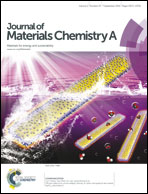Adaptive kinetic Monte Carlo simulation of solid oxide fuel cell components†
Abstract
Ionic conductivities in the solid oxide fuel cell (SOFC) electrolytes yttria-stabilised zirconia (YSZ), calcia-stabilised zirconia (CSZ), gadolinium-doped ceria (GDC) and samarium-doped ceria (SDC) and the cathode material lanthanum strontium cobalt oxide (LSCO) are directly calculated using DL_AKMC, an adaptive kinetic Monte Carlo (aKMC) program which assumes limited a priori knowledge of the kinetics of systems. The materials were simulated over several milliseconds and over the range of experimentally most relevant temperatures and dopant concentrations (2–18 mol% for doped zirconia, 5–25 mol% for doped ceria and 5–80 mol% for LSCO). Ionic conductivities of the electrolytes at 1000 K are in good agreement with the observed values: CSZ in the range 3 × 10−3 to 1 × 10−2 S cm−1 depending on dopant concentration, YSZ 4 × 10−3 to 3 × 10−2 S cm−1, GDC 1 × 10−2 to 5 × 10−2 S cm−1, SDC 1 × 10−2 to 7 × 10−2 S cm−1. LSCO is predicted to have an ionic conductivity of the order of 10−2 to 10−1 S cm−1 depending on Sr content. Average activation energies over all migration processes are 0.4–0.5 eV for the stabilised zirconias and 0.2–0.3 eV for the doped cerias and 0.3 eV for LSCO, in agreement with experiment. aKMC provides a distinct advantage over traditional KMC methods, in which one has to provide a list of system state transitions. Here, all of the state transitions are dynamically generated, leading to a more accurate simulation of the kinetics as the system evolves.


 Please wait while we load your content...
Please wait while we load your content...